Episode 33 Show Notes
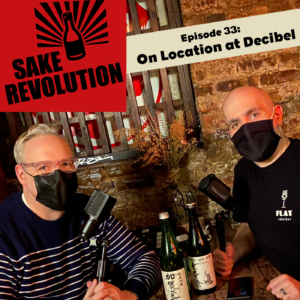 Season 1. Episode 33. Do you know your way to New York’s most legit and old school sake bar? Walk east on 9th street until you see the “On Air” sign just before second ave. Descend the stairs and behind the door you’ll find Decibel, the ultimate underground sake bar. If you find yourself in a dark and graffiti-covered basement, you’re in the right place. Opened in 1993 by East Village restaurant pioneer Bon Yagi, Decibel has welcomed the spectrum of NYC nightlife in search of sake for over a quarter century – and with over 100 sakes on the menu, there is plenty of sake to choose from. What better place for Tim and John to do their first “on location” episode, than from New York’s most classic sake bar. Sit back, relax and take in the sounds and atmosphere of Decibel as our hosts recall their underground (mis-) adventures in sake. Special thanks to Decibel’s Cho-san for arranging our recording session!
Season 1. Episode 33. Do you know your way to New York’s most legit and old school sake bar? Walk east on 9th street until you see the “On Air” sign just before second ave. Descend the stairs and behind the door you’ll find Decibel, the ultimate underground sake bar. If you find yourself in a dark and graffiti-covered basement, you’re in the right place. Opened in 1993 by East Village restaurant pioneer Bon Yagi, Decibel has welcomed the spectrum of NYC nightlife in search of sake for over a quarter century – and with over 100 sakes on the menu, there is plenty of sake to choose from. What better place for Tim and John to do their first “on location” episode, than from New York’s most classic sake bar. Sit back, relax and take in the sounds and atmosphere of Decibel as our hosts recall their underground (mis-) adventures in sake. Special thanks to Decibel’s Cho-san for arranging our recording session!
Skip to: 00:19 Hosts Welcome and Introduction
Welcome to the show from John and Timothy
Skip to: 01:19 On Location: Sake Bar Decibel
Sake Bar Decibel
https://www.sakebardecibel.com/
240 E. 9th St. New York, NY 10003
No reservations
Instagram: https://www.instagram.com/sakebar.decibel/
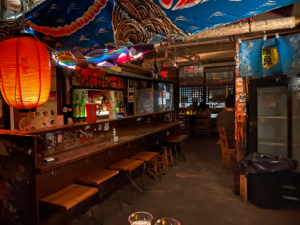
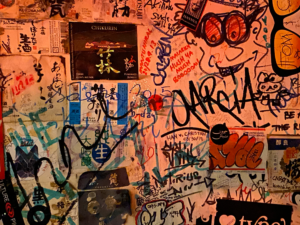
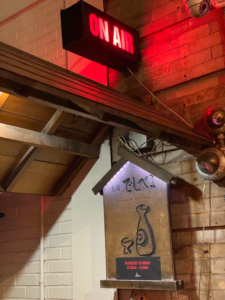
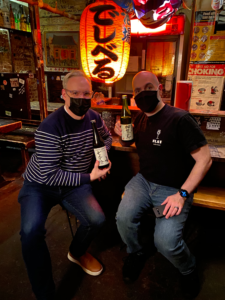
Skip to: 09:54 Sake Tasting: Kagatobi Junmai Ginjo
Kagatobi Junmai Ginjo

Brewery: Fukumitsuya
Classification: Junmai Ginjo
Acidity: 1.4
Alcohol: 16.0%
Prefecture: Ishikawa
Seimaibuai: 60%
SMV: +4.0
Rice Type: kinmonnishiki, Yamadanishiki
Brand: Kagatobi
Skip to: 16:26 Sake Tasting: Shichihonyari Junmai
Shichihonyari Junmai
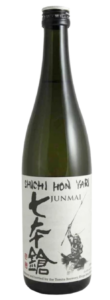
Acidity: 1.5
Brewery: Tomita Shuzo
Alcohol: 15.5%
Classification: Junmai
SMV: +4.0
Prefecture: Shiga
Seimaibuai: 60%
Brand: Shichi Hon Yari
Rice Type: Tamazakae
Yeast: 1401
Sake Name English: Seven Spearsmen
Importer: Joto Sake
Skip to: 28:47 Show Closing
This is it! Join us next time for another episode of Sake Revolution!
Episode 33 Transcript
John Puma: 0:21
Hello everybody. And welcome to a very special sake revolution. America’s first sake podcast. I’m your host, John Puma from the Sake Notes, the administrator of the internet sake discord, and the guy on the show. Who’s not a Sake Samurai.
Timothy Sullivan: 0:34
And I’m your host Timothy Sullivan. I am the Sake Samurai, a sake educator, as well as the founder of the Urban Sake website and together John and I will be tasting and chatting about all things, sake and doing our best to make it fun and easy to understand.
John Puma: 0:50
That’s all right. And, uh, Tim, I got to say something. This is a, this is a very special episode, as I mentioned that the, at the start for more than one reason, there’s, there’s not just a, we’re not talking about tokubetsu today. I’m sitting at a table, and across the table from me. It’s you,
Timothy Sullivan: 1:06
we are here in the flesh.
John Puma: 1:08
Yeah, this first off, this is a little weird. but, that’s not all, what else is going on here?
Timothy Sullivan: 1:13
Well, we are on location and you may hear a little rumbling in the background, a little noise back there.
John Puma: 1:18
music,
Timothy Sullivan: 1:19
Yeah. We are live on location and we are at one of my favorite places in New York for sake. We are at sake bar Decibel.
John Puma: 1:26
Yes, legendary,
Timothy Sullivan: 1:29
it is old school. Legit.
John Puma: 1:32
Absolutely. this is the place that when you’re getting into sake, people who are already into sake, I hear that you’re getting into sake and they’re like, Oh, I’ve been to Decibel yet.
Timothy Sullivan: 1:41
absolutely. So for those listeners, who’s never been to New York. I’ve never been to Decibel. John, why don’t you describe our environment here? What is this like?
John Puma: 1:52
all right. So it’s talking about our Decibel is interesting and unique because it is not like any place else in New York, and it’s also not like any place else I’ve ever been to in Japan. it is probably what a lot of people in New York think a bar in Japanis like. There’s a lot of, it’s very dark it’s in the basement. There is very scarce lighting. There are stickers and labels and graffiti all over every surface of this place. And on top of all that, a sake list that’s cruising in and around a hundred bottles.
Timothy Sullivan: 2:23
Yes. So this is an underground sake, a punk lair kind of place. Lair,
John Puma: 2:29
like that.
Timothy Sullivan: 2:31
it is dark it’s dingy. It is underground. It’s very East village.
John Puma: 2:36
Yes it
Timothy Sullivan: 2:36
Yeah And it was open in 1993 So it’s been around for 27 years Yeah That makes it legit this this is
John Puma: 2:48
the first part
Timothy Sullivan: 2:51
Oh totally
John Puma: 2:52
Oh wow
Timothy Sullivan: 2:53
Yeah And The person who opened sake bar decibel, Bon Yagi, went on to have an empire of Japanese and sake restaurants in New York city So this was one of his first places And I think it was originally a loungy place where you know they would have whiskey and Sake and it Has morphed over the years into a real legit hangout for sake fans
John Puma: 3:23
yeah Yeah And if you are at home and you have Netflix and you want to see what this place looks like you can do that grab your Netflix and watch the last episode or the last five minutes of the last episode of Marvel’s iron fist And you will see a place that they describe as being in Japan Yeah And it but it is actually Sake Bar Decibel
Timothy Sullivan: 3:47
I did not know
John Puma: 3:49
I gotta try to bring these little nuggets out every now and again Tim
Timothy Sullivan: 3:51
That is amazing All right
John Puma: 3:54
by the way everybody if we sound a little muffled uh that is because we are a little muffled We are uh observing COVID precautions and we are wearing face masks while we sit across from each other and and talk to you
Timothy Sullivan: 4:06
Yes but the moment the sake comes out this mask is coming off
John Puma: 4:10
and then it’s gonna go back on and it’s gonna come off again It’s very interesting Uh so so so when did you first come here
Timothy Sullivan: 4:18
Well I remember very distinctly I had just gotten into sake and my research online about where to go for sake in New York sake bar Decibel was way up there And I had gone to NYU as a college student and
John Puma: 4:34
with the area Okay
Timothy Sullivan: 4:35
and I made a beeline for sake bar Decibel and I remember being kind of freaked out because when you come down the stairs you don’t know what’s behind the door Right And then there’s also a rope there So they have this rope and I read online that the reason they have the rope to keep people from coming in is that this is not a bar where you stand around And cram in together This is a bar where you sit down and that is something that they want you to really relax and enjoy sake not be crammed in with your Miller light and you know everybody rubbing elbows one on top of the other So I wasn’t sure what to expect You came in sat down and the first thing I did was I asked the server for recommendation and she brought me a very delicious sake and I the one Thing I do remember about that night is that I liked the sake so much I asked the server to write down the name on a piece of paper for
John Puma: 5:36
And did you remember what that was
Timothy Sullivan: 5:38
Yes It was a sake called kansansui which is not available at Decibel right now but that’s from Fukuoka And I was just at the most eager stages of sake discovery
John Puma: 5:55
Try and get everything get your hands on
Timothy Sullivan: 5:56
and kind of loving everything I tried
John Puma: 5:58
That was awesome
Timothy Sullivan: 5:59
Yeah What about your first time
John Puma: 6:01
Well I when I first started getting into sake I was going to places that were more mid townie uh because I did not go to NYU and I did not spend a lot of time in the East village Uh and a friend of mine lived very close to the Midtown location of sake bar Hagi And so we went there every Friday night that we were going through their sake list rather quickly and we kind of ran out of stuff and uh wanted to explore some more and I remember reading about this place online but I saw some pictures and I was like I don’t know I like this looks I don’t know if I like it It was it was one of these very like it looked too authentic and like I just felt like I don’t bowl I don’t belong at a place like this It’s too cool Like you know like that kind of thing And uh eventually a friend of mine who introduced me to sake and I came down here and braved it And I remember we walked in the door we went down the stairs and walked in the door And when you walk in the door the first thing you see apart from the rope is that there’s a small bar to the right And that’s kind of all you see And I was like Oh my God this place is so tiny
Timothy Sullivan: 7:10
I forgot about that Yeah There’s a little entrance area
John Puma: 7:15
And I’m like this is just going to take a forever to get in here Oh my God And they’re like I don’t know 10 minutes and 10 has go by that probably more like 15 or 20 And they raised the rope and took us into the back room which is the vast majority of the space here And I remember just being like what I was completely bowled over by it And you sat down and and when they brought over the sake list I was like what I I had never seen this many different sakes on a page before It was amazing It was bonkers to me It broke my sad little brain
Timothy Sullivan: 7:49
Yeah I do have one other association with sake bar Decibel
John Puma: 7:53
And what is that
Timothy Sullivan: 7:54
And well sake bar Decibel used to open around 8:00 PM They opened earlier now but in the old days they used to open at 8:00 PM and they would close at 4:00 AM
John Puma: 8:08
Well in normal times
Timothy Sullivan: 8:10
So this was always when I got into sake hardcore this was always like the last stop the after after after party And
John Puma: 8:20
all roads lead to decibel
Timothy Sullivan: 8:21
yes So when you’re on your third place or your fourth place it’s the end of the night Maybe you had a little bit too much to drink That you may wake up with some fuzzy memories of decibel maybe not feeling your best So I do have a bit of an association with decibel as being like my hangover place
John Puma: 8:45
I have uh similar um stories and I’m not going to go into detail on but um but they’re they’re formative Nonetheless They’re important
Timothy Sullivan: 8:57
Yes So my my advice to our listeners when you come to decibel um drink response
John Puma: 9:05
and a water hydrate One one drink one water That’s that’s the rule At least that should be
Timothy Sullivan: 9:10
there
John Puma: 9:12
Um so Tim It’s been a very long time since I’ve been able to have a drink with you
Timothy Sullivan: 9:17
yes we are Face-to-face
John Puma: 9:19
Um yeah and we have some sake here we asked the manager for some recommendations And we have two bottles that we’re gonna we’re gonna take some steps up and we’re talking about just like we usually do Yeah We’re just because we’re at a place but a hundred sakes doesn’t maybe we’re going to drink a hundred sakes guys This is not how this works
Timothy Sullivan: 9:37
Okay John So which sake are you going to pour too And this is fun as well because normally when we’re on zoom I have one sake You have one sake and we have to just Talking to each other about what it tastes like but today we’re live in person We can actually both taste the
John Puma: 9:54
Yeah you don’t have to just take my word for it The first thing we’re going to open up is this Kagatobi Junmai Ginjo. Kagatobi is from a brewery located in Ishikawa And the name of the brewery is Fuku mitsuya And again this is their Junmai Ginjo Polished down to 55% and using both Yamadanishiki and kimon nishiki rice
Timothy Sullivan: 10:24
yeah So I’m going to go ahead and open this up for us Okay John that’s for you
John Puma: 10:35
Thank you very much Tim
Timothy Sullivan: 10:40
All right So we get to slip our mask down for a second and give this a smell and a taste
John Puma: 10:50
Oh And by the way Tim uh kanpai!
Timothy Sullivan: 10:53
Kanpai! Yeah it’s been such a long time
John Puma: 10:58
It has so what are you getting on the nose here
Timothy Sullivan: 11:01
Well let’s give it a smell. Well it’s no it’s very lightly fruity and a very gentle aroma not strong
John Puma: 11:09
uh by the way guys we can’t really give you much of a commentary on the color It’s very dark in here It is a little bit fruity and light There is a little bit of a I want to say like uh almost a Koji aroma on it Just a hint of it
Timothy Sullivan: 11:25
Yeah And like you said this is a Junmai ginjo grade And I happen to know from the manager Cho-san, that he is from Ishikawa and he picked this sake because it’s from Ishikawa it’s a wonderful part of Japan for sake Very gentle aroma a little bit ricey a little bit fruity good balance let’s give it a taste
John Puma: 11:50
Sure thing
Timothy Sullivan: 11:51
So I see what you mean with that Koji aroma There’s there’s a little bit of that ricey-ness a little bit of earthiness on the palate. And a little bit of dryness too
John Puma: 12:02
Yeah I want to say that like the aroma I mean we talked about this before on the show that we we like it when uh a makes good on the promise that the aroma is making and it very much like you do you smell this and then you taste it and it’s you’re very much getting exactly what you expect from what you want You smell
Timothy Sullivan: 12:22
Yeah Yeah You know when I first very very first smelled this I thought Oh this is going to be a little dainty a little fruity It’s coming out a little bit more earthy more Koji driven some riceyness going on
John Puma: 12:37
Yeah this is layered This is very interesting Not a simple sake by any means
Timothy Sullivan: 12:43
No I think that this would be a good sake to have with food For sure Yeah It’s got Some weight to it a dry finish So I did have the pleasure to visit this brewery Fukumitsuya Yeah I went there years ago in Ishikawa and it is one of the larger breweries in this region Yeah So they’re they’re on the larger size but they produce several brands as well So Kagatobi this particular one is one of several brands that this brewery makes
John Puma: 13:16
Do they do any of their other brands make it over to the States
Timothy Sullivan: 13:19
I don’t think so I think there the rest of them are all in Kanazawa Ishikawa region Oh well Ishikawa is do you remember that story I told about going to the Noto peninsula being dropped off on the road and I was in the middle of nowhere That story was Ishikawa I was going to Sougen brewery
John Puma: 13:44
yes
Timothy Sullivan: 13:44
Yeah So Ishikawa is a wonderful place And the city where this is located is called Kanazawa And Kanazawa is known as a little Kyoto Yeah it was not destroyed during the war and it has A lot of Japanese cultural influence they have intact houses from the Edo period from the samurai period Um it’s known for Makie which is gold working um and lacquering and all types of Japanese arts and crafts are preserved there And it has a really thriving sake culture as well So kanazawa is an amazing place to visit and to put the cherry on the Sunday they just a few years ago put in a shinkansen, a bullet train from Tokyo to Kanazawa It used to be harder to get to but now That they have the bullet train it is a lot easier to get there
John Puma: 14:48
So what does that mean That if somebody went now they wouldn’t have your country road experience?
Timothy Sullivan: 14:53
No I brought that country road experience on myself I was visiting a brewery that literally was in the middle of nowhere but Kakatobi is right in Kanazawa city So if you visit Kanazawa to take in the culture you can stop by and they have an amazing gift shop I remember this distinctly the buyer for the gift shop is really into modern Japanese design and the carafes and sake cups that they have on sale There are beautifully designed almost like MoMA museum of modern art quality so amazing And they also sell sake kasu ice cream there I remember how do I remember that I remember the ice cream That’s what I remember
John Puma: 15:35
uh by the way everybody if you are interested in Tim’s uh Sojourn on the on a peninsula initia Kawa And that’ll be episode four of self-care revolution way back in April
Timothy Sullivan: 15:48
seems like a different time
John Puma: 15:50
was uh um since I’ve never I’d never been like I said and uh maybe you know like everything else just goes on the wishlist I think
Timothy Sullivan: 16:00
it’s really worth the trip I mean John you and I have been saying for months now that we’re going to take sake revolution on the road Here we are We made we made it to the East village That
John Puma: 16:12
It’s about as far as we can go I want to say that if you’re going to have sake a on the East coast of the United States probably the best bar you can go to
Timothy Sullivan: 16:22
this this really is like a ground zero epicenter for sake
John Puma: 16:26
Yeah Um so should we open up our second bottle All right So while I’m opening this up Tim what do we
Timothy Sullivan: 16:36
have here Yeah So this is a really delicious sake called Shichi Hon Yari. So this is a sake from a Shiga prefecture And Shiga is one of the prefectures that is landlocked meaning it doesn’t have access to the ocean but the largest Lake in Japan is part of Shiga lake Biwa This is a Junmai sake from Tomita brewery we have a rice milling rate of 60 and the sake rice that they use is Tamazakae Again milled to 60% the SMV sake meter value how sweet or dry this is a plus four and that’s the same as our previous sake the Kagatobi
John Puma: 17:21
All right Well let’s get this guy open and there you go Tim
Timothy Sullivan: 17:27
Thank you
John Puma: 17:28
So most of the time when I’ve had a most of my experience with Shichi Hon Yari has been more of their their seasonal stuff specific If I want to say they’re Hiyaoroshi is the one that I think of when I think of this brand because it’s something that when it comes around to New York it’s exciting uh exciting type of sake Again I’m a big fan of hiyaoroshi which I believe we’ve covered on the show before Well yeah I’m not sure The last time I had this particularJunmai I’m excited to try it
Timothy Sullivan: 18:00
we’re getting a really good contrast here with brewery size So Kagatobi the fukumitsuya is one of the largest breweries not only in Ishikawa but it’s a big brewery for Japan It’s a mega brewery and they make wonderful craft sake but they have larger production Scales but the shichi yon yari there is uh just a few people a handful of people who make this sake So this is a true microbrew
John Puma: 18:29
Oh so this is uh this is some craft brewery
Timothy Sullivan: 18:34
so let’s give these shichihonyari a smell
John Puma: 18:44
And plus it’s a little more rice forward less definitely Uh not getting that men knocking on that Koji aroma Nor nor am I getting a lot of fruit It’s kind of like a little little rice and then like kinda like that that fresh grass kind of thing like that It’s very light smelling it always In other words I’m smelling it and I’m thinking this is going to be a light sake relatively speaking
Timothy Sullivan: 19:10
it smells fresh There’s a brightness in the aroma but it does smell rice but not in a cooked or oxidized in any way Very bright and fresh
John Puma: 19:22
I’m not familiar with this rice type though So I’m kind of excited to see what that brings to the table
Timothy Sullivan: 19:26
Let’s give it a taste So this has umami This is umami You think about
John Puma: 19:37
a
Timothy Sullivan: 19:38
savoriness almost a little bit of a mushroomy character
John Puma: 19:42
not overwhelmingly mushroom me but but
Timothy Sullivan: 19:44
a hint a hint Like a wafting mushroom from the other room if someone had mushrooms in the other room
John Puma: 19:53
Okay
Timothy Sullivan: 19:55
Yeah So the Shichihonyari the name means seven Spears men and there was a samurai battle near where the brewery was and has something to do with seven Spears That’s all I know
John Puma: 20:10
That’s actually pretty cool A lot of breweries don’t have that attached to their branding
Timothy Sullivan: 20:16
This brewery has been around for about 500 years 500 No joke So the the family history goes back hundreds and hundreds of years and it is still maintaining that craft level of quality but you can taste how well integrated and the structure of this sake. It’s really delicious
John Puma: 20:43
Serious craft behind us And this is not a modern tasting sake at all This tastes very classic
Timothy Sullivan: 20:49
Yes you can almost picture the samurai with this seven Spears like drinking this
John Puma: 20:55
taking a break from their rigorous day of spearing Whomever needs spearing
Timothy Sullivan: 21:02
and I don’t want to brag or show off but I did go to this brewery
John Puma: 21:09
Did you and Cho san sit down and you pick these sakes, is that what happened?
Timothy Sullivan: 21:13
No no I just I I’ve I’ve taken a lot of trips to Japan What can I say? So the Tomita family owns the Shichihonyari brewery And it is a very as I mentioned a very small scale production but they have done something that I think is really admirable They’ve reached outside of Japan And even though there are a few people working there super small scale production they had a dream to export their sake and get it out to the world So I really admire that in a brewery that is that size that scale They want to share their craft product with the world And we’re the beneficiaries of
John Puma: 21:57
Yeah we are This is this sake is very interesting to me because it’s not My style of sake Um in fact like these games that have that that mushroomie uh umami flavor are usually ones that I don’t typically go for They usually they they turned me off a little bit I I don’t like mushrooms very much but there’s a brightness that counterbalances that in this sake And so it makes it really there’s there’s so much more besides those two flavors that it’s layered very nicely and it’s so nice to drink It’s it’s it’s really simple even though it’s this umami driven Junmai it’s very very drinkable very simple very nice sake
Timothy Sullivan: 22:44
Yeah I couldn’t agree with you more I think that you know it it does have a savory character to it And everybody who listens to sake revolution is going to know that John Puma likes the fruity quaffable easy drinking sakes And this also I mean it’s dark in here but I can see and I know from having had this in the past there’s a little tinge of yellow to this
John Puma: 23:10
Yeah we’re holding it up to the one light source that’s nearby And I think I see what you’re saying And if it’s showing up in that and it’s probably got some color to it
Timothy Sullivan: 23:20
Yeah So there’s a little bit of color to this The riceiness really comes through and there’s an earthiness but it is an elegant characteristic
John Puma: 23:30
this is that that kind of sake That kind of earthy umami during sake for someone who doesn’t like earthy umami-driven sake Like it it’s it it appeals to I think to anybody it’s really nice
Timothy Sullivan: 23:44
bingo And I have a secret hot tip
John Puma: 23:48
Is this a literal hot
Timothy Sullivan: 23:49
This is a literal hot tip for anyone who wants to order Shichihonyari Junmai if you order this And get it served warm Oh my God It is amazing served warm
John Puma: 24:04
Well uh for those listening at home we this is being sort of chilled right now but now I have I have aspirations towards future ideas
Timothy Sullivan: 24:13
should we ask him to warm
John Puma: 24:14
I think we should
Timothy Sullivan: 24:17
I asked our manager Cho-san to bring us a sample of shichi Honyari warmed up And we’re going to try it right now So give me your glasses kanpai! Cheers!
John Puma: 24:31
It’s like we snapped our fingers and suddenly there warm sake in front of us
Timothy Sullivan: 24:35
That’s what planning ahead does for you Now give this a smell
John Puma: 24:40
No it’s most a little bit like steamed rice
Timothy Sullivan: 24:44
rice and I can tell you from having worked in a Koji room this is what Koji smells like Like this is very much a Koji aroma And a little peppery okay Let’s give it a taste Oh my God Savory velvety
John Puma: 25:09
This is not the same sake
Timothy Sullivan: 25:11
It tastes like a totally different sake but isn’t Oh my gosh I feel like warming tingling through my body Like it is warming from head to toe
John Puma: 25:20
okay This could just be my Christmas sake? This is really nice when it’s warmed up Hmm And and I as I mentioned this is wildly different and we talked about this in the past that when you warm ups okay When you play with temperature with sake you’re going to get very different experiences And this is a prime example Like this is so different uh and equally enjoyable but completely different experience completely different sake
Timothy Sullivan: 25:49
right Yeah I agree completely It is so delicious Warmed up though there’s a nuttiness there too
John Puma: 26:00
there’s a nuttiness There’s a little bit of it reminds me of of of like porridge because the rice notes are still there but it’s nice and warm and inviting It’s comforting Those are the feelings I’m getting from tasting it It’s very nice I don’t I don’t drink a lot of warmed up sake I you know what I probably don’t drink enough Warmed up sake
Timothy Sullivan: 26:20
well the season is upon us It’s getting colder outside and warm sake is absolutely fantastic It gets a bad rap Sometimes we talked about this with our friend Chizuko when we did our warm sake exploration but the thing that I love about warm sake is that it’s very visceral You feel it in your body like it warms you like having a hot toddy you know it warms you up from the inside out and that’s something I love And this is such a good sake to serve warm and serve chilled We’ve loved it both ways
John Puma: 26:55
I didn’t know going into this that having this warmed up would be an experience I I just never heard to me
Timothy Sullivan: 27:02
Yeah well being on location at decibel we are able to get warm sake
John Puma: 27:11
warmed sake, chill sake We can sit across from each other and by the way everybody uh for the warm sake conversation that we had whith Chizuko that was back in episode 12 says John Puma at your sake revolution historian
Timothy Sullivan: 27:27
It felt just like yesterday
John Puma: 27:29
Uh that was in June Tim, Yeah It’s like 2020 has been 20 years
Timothy Sullivan: 27:39
I have to say of the three sips that we’ve had tonight We had the Kagatobi Junmai ginjo chills We had the shichihonyari Junmai chill And now we have the shichihonyari junmai warm I just have to say
John Puma: 27:54
we’re playing favorites Is that
Timothy Sullivan: 27:55
We’re playing favorites We’re going
John Puma: 27:57
what are we doing What do we do
Timothy Sullivan: 27:58
I think that the warm shichihonyari Is my favorite It’s so yummy
John Puma: 28:04
well I’m going to meet you halfway which I guess kind of gives away my response because while I really am surprised I really am enjoying this warmed up I liked it better chilled I enjoyed it More chilled. Wonderful sake uh either way but if I had to pick a bottle and a method we did not have the kagatobi warm I don’t know if that lends itself to warming but that’s Shichihonyari chilled really did something for me And it I think part of it is that it’s a profile that I’m usually not that fond of and it it turned it on its head and made me love it And that’s exciting That’s interesting to me
Timothy Sullivan: 28:47
This was so much fun It’s so good to see you in person John
John Puma: 28:51
Likewise Tim for our readers at home where specifically Yeah
Timothy Sullivan: 28:55
well if you want to come visit decibel yourself you want to come to the East village It is East ninth street and second Avenue near the corner And you want to look for a sign that says on air and you look for the stairs going downstairs and that’s going to get you to decibel It’s definitely
John Puma: 29:16
It is And a fun fact I had been to a soba restaurant across the street called sobaya Many times and had seen this place and didn’t realize this was sake Bar Decibel This was that place I’d been hearing about So when I actually went down here to go to decibel I was like wait a minute I I know this place I pass this place all the time
Timothy Sullivan: 29:42
So that’s where you want to go look for the on-air sign Go down the stairs and you’re going to be in sake Heaven
John Puma: 29:51
Okay Heaven is down the stairs
Timothy Sullivan: 29:56
I want to thank you for coming out to the East village and I want to thank all of our listeners so much for tuning in We really do hope that you’re enjoying our show If you’d like to support sake revolution one way that you can really help us out would be to take a couple of minutes and leave a written review on Apple podcasts It’s one of the best ways that you can help us to get the word out about our show So
John Puma: 30:19
and please be sure to subscribe wherever you download your podcasts And while you’re at it tell a friend and have them subscribe too
Timothy Sullivan: 30:27
that way you won’t miss an episode And as always to learn more about any of the sakes we’ve tasted or any of the topics we talked about in today’s episode be sure to visit our website SakeRevolution.com for all the detailed show notes
John Puma: 30:42
And if you have sake questions that are burning in your mind that you need to answer it or if you have some ideas or sakes you want us to try topics he wants to talk about sake education corner ideas Please reach out to us at [email protected] and we’re going to read them So until next time Please remember keep drinking sake and Kanpai!